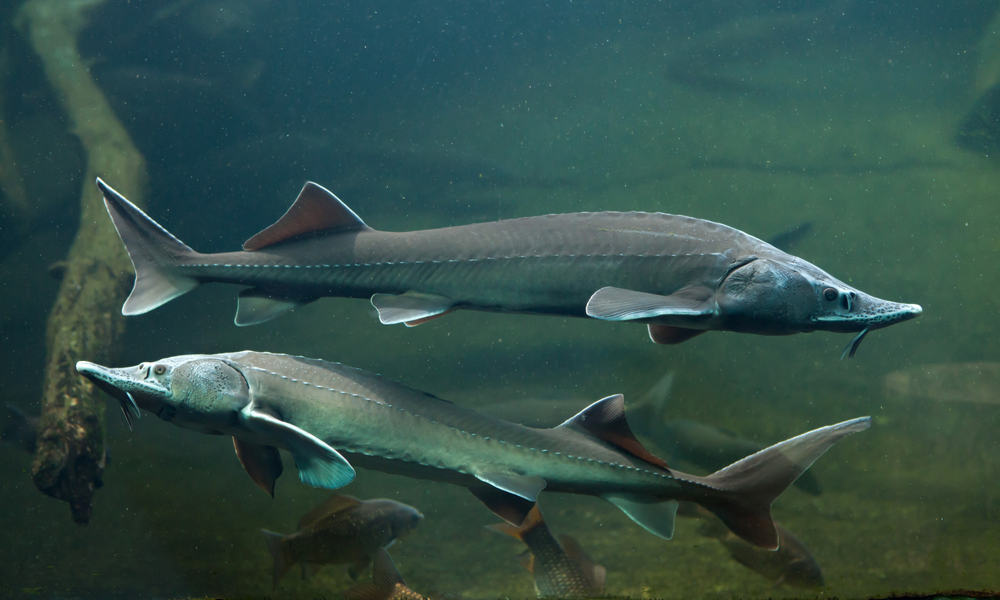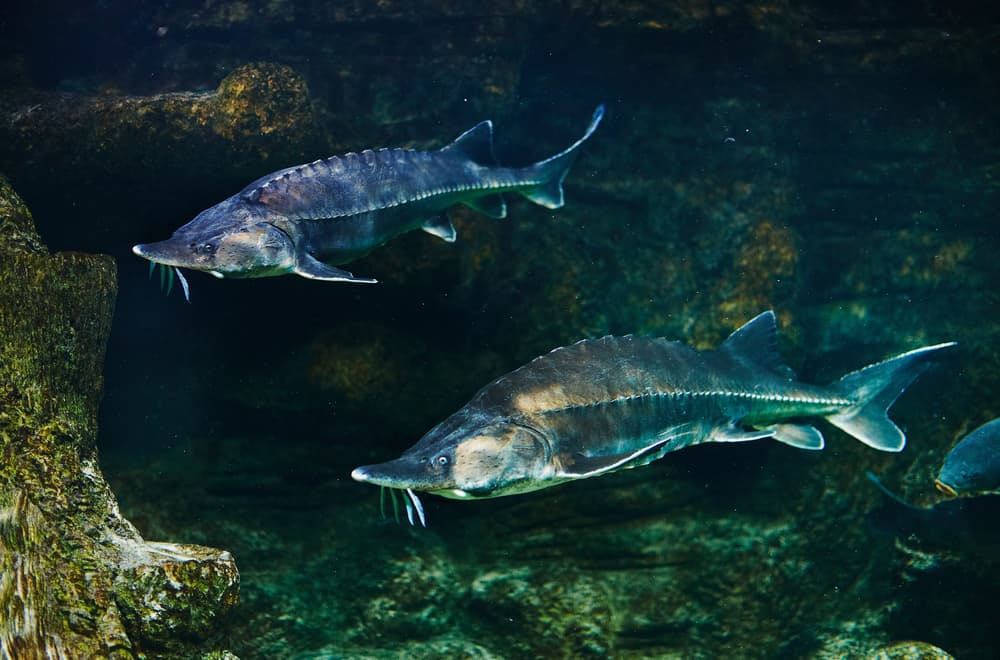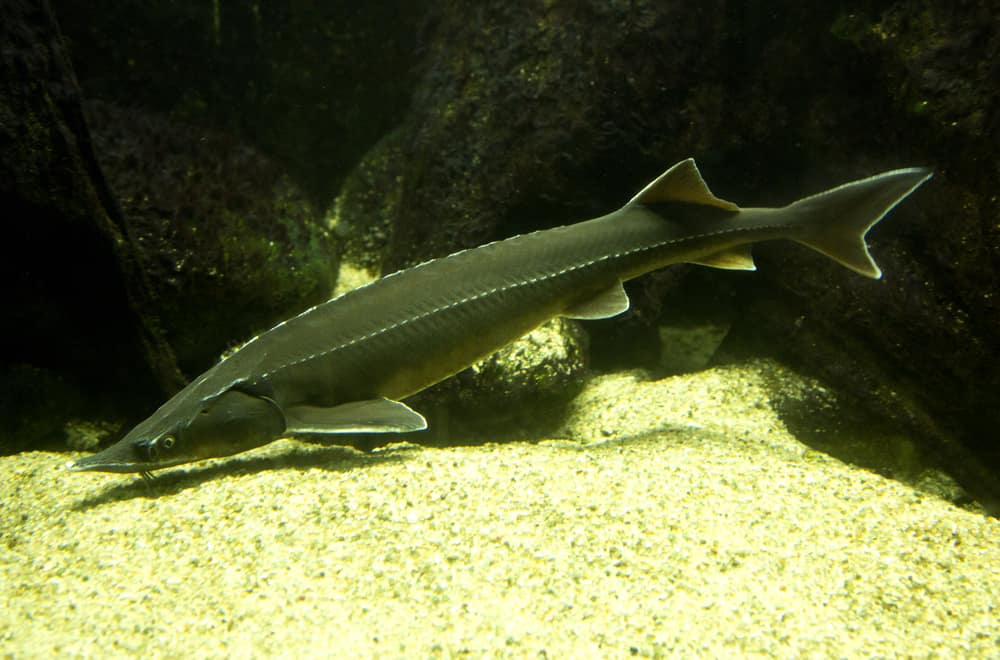Many fish lovers want to what do sturgeon eat. This name is used to distinguish 27 different animals belonging to the Acipenseridae family. These fishes live long lives and need a lot of time to mature. Unfortunately, several sturgeon species are extinct, and there is a chance a few other animals will also go extinct soon.
Sturgeon Habits and biology
The first record of these fish dates back to 245 to 208 million years. As such, experts consider them as one of the most ancient actinopterygian fish that live up to this day. Over time, sturgeons underwent very little change. As a result, their evolution is very slow, and many biologists regard them as living fossils.
The species lives in the northern hemisphere, in oceans and rivers with a temperate climate. Many sturgeon species live in oceans and will go down to a river every few years to spawn. They usually do so during summer or spring. However, certain sturgeon species only live in fresh water and will never have the opportunity to reach oceans.
One of the main issues that sturgeons face is excessive fishing. This species is very popular for its eggs, which companies use to make caviar. As a result, some of them are critically endangered, and three species are already extinct.
In many ways, sturgeon resemble paddlefish that belong in the group of Acipenseriformes. They have scutes (bone plates) that cover their heads. Besides the head, these plates also go along their bodies. They have a heterocercal tail, where the upper part is longer than the lower lobe.
- Sturgeon’s diet can vary significantly based on species. While some focus on crustaceans and shellfish, there will also be those who only eat fish.
- Given that these animals have no teeth, they cannot catch prey as other fish do. Instead, they will suck them into their mouth. Although this might sound inefficient, sturgeons can suck in larger prey like salmon.
- The fish doesn’t rely on eyesight to catch prey. Instead, they have a combination of sensors that allows them to detect things in the water. The animal has electroreceptors on its head that pick up electric fields that other species emit.
- Besides feeding, sturgeon relies on electroreceptors during migrating and mating.
- Sturgeons like to leap out of the water. When doing so, they will make a major splash that is transferred for half a mile on the surface of the water.
What do sturgeon eat in the wild?
Biologists categorize sturgeons as carnivorous benthic feeders. This means that the fish focuses on animals living at the bottom of lakes, rivers, and oceans. Most species live close to the floor, so it makes sense they would focus on such prey.
The animal is not able to eat any plants. This is because they don’t have the necessary enzymes that would allow them to digest plant matter. So, if you have sturgeons, avoid giving them wheat, beans, and other plants. Although they might eat such food, they won’t digest it quickly, leading to malnourishment and sickness.
White sturgeon is the stronger, largest fish you can find in North America. It can swallow a lot of other fish, including salmon, herring, and flounder. But they also eat whole crabs, barnacles, and muscles. It isn’t uncommon for sturgeons to eat dead bodies of other fish and water animals.
Here are some of the things they like to eat:
- Shellfish (shrimps, mussels, clams, etc.)
- Shells
- Crustaceans
- Different fish types
- Macro and micro invertebrates
- Crabs
- Barnacles
- Insect larvae
This species has high protein needs. Sturgeons need food approximately two to three percent of their body weight. Younger animals will need even more. The fish is rather slow, and it might need some time to finish its daily feeding cycle.
Given that they live close to the lake, river, and ocean floor, it can be really hard for them to see their prey. This is why they developed other senses allowing them to detect animals based on their electromagnetic field. They also have a very strong sense of smell. Sturgeon’s whiskers can detect taste and smell within the water.
When sucking in animals, the fish will also suck in some water. That will allow them to strain out sand and slit through gills.
16 Facts about sturgeon
There are so many specific things that set sturgeon apart from other fish. Here are some fun facts about this animal:
- Although this species usually focuses on live prey, it doesn’t have any trouble eating dead fish and frozen foods. So if you have sturgeon in an aquarium, you can give it some frozen fish food, and it will likely eat it.
- This animal continues growing for as long as it lives. On average, a sturgeon will be somewhere between 0.9 to 1.5 meters long and have between 3.5 and 36 kilograms. The larger animals can go up to 2.5 meters and have more than 140 kilograms. Keep in mind there are some differences between sturgeon species.
- Sturgeon has an enormous life span. On average, they will live between 50 to 80 years, but some can reach 150 years of age.
- Sturgeons like to tail walk. This is a situation when they stand on their tail, above water, and start moving backward. Tail walking is especially common during warm weather. They also like to do other acrobatics, like jumping out of the water and twirling in the air. So in that sense, they are very similar to dolphins.
- Besides jumping out of the water, it isn’t uncommon to see a sturgeon swimming on its back. Unlike jumping, which is mainly recreational, they use this move to catch insects that can be found on the water surface. Given their anatomy, swimming on their back is the only way they can catch such prey.
- If you have a sturgeon in the aquarium, you might have seen it swim through bubbles that the filter makes. They probably do this as a way of cleaning their gills.
- These animals like to lay down on top of each other when on the floor.
- Sturgeons would make for great pets, although people rarely keep them. Each one of them has specific behavior, and you can easily recognize them based on their tendencies. Among others, you can see a difference between individuals based on their playfulness and how they eat.
- There is no way to determine the sturgeon’s age from the outside. So when scientists want to determine their age, they count the bone rings, which are on their pectoral fins.
- Sturgeons are ancient fish. Most of them look like living fossils, especially species such as lake sturgeon. They are regarded as heritage animals in many regions of the world, such as Manitoba.
- In certain parts of North America, indigenous people call sturgeons “Buffalo of the water.”
- Throughout history, these fish have been used in different ways. Men hunted them for their meat, but they also used their eggs to make caviar. Old indigenous tribes used their bones and cartilage to create spearheads, needles, and arrowheads. Within their bladders, there is a substance that can be used to create paint and glue.
- The species experienced a major drop in numbers during the 1800s. This is because people started finishing them for their eggs, which they used to create caviar. From this point onward, the fish was slowly domesticated and used for its meat and eggs. For example, in 1900, people harvested 445 tonnes of sturgeon from Lake Winnipeg, leading to sturgeon population decline and subsequent closing of the fishery.
- Nowadays, you can no longer kill sturgeon. Even if you fish them out of the water, you have to release them. You cannot harvest the species commercially in North America. Today, there is an effort to conserve the species and create a safe environment for it.
- Sturgeons need a lot of time to mature, which isn’t really surprising given their longevity. To start reproducing, males have to reach at least 15 years of age, while females have to be at least 25 years old. A female can create offspring every four to six years. This is another problem with the species, as it makes them very vulnerable to outside influence. Baby fish will spawn in the spring when the water temperature reaches about 11 degrees Celsius.
- A female sturgeon can release between 100,000 eggs to one million. Before releasing them, the animal will go to an area with a rocky bottom and fast water. Here, various males will surround her by swimming in circles. Males will drum her sides, thus allowing the release of eggs. These eggs will be very sticky, and they will start scattering around based on the river current. In a bit, they will start dropping to the floor where little sturgeon will start hatching.
Summary
Sturgeon is one of the most ancient animal species. The animal was hunted for its meat, eggs, and bones, but there is an effort to protect them as of late.
This is a very jovial species with pronounced character. Unlike other fish, they don’t have teeth. When they want to eat, they suck in other animals. The fish doesn’t have good eyesight and relies on other senses to find its prey.


